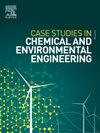Mechanical, environmental, and cost evaluation of concrete using recycled polypropylene
Q1 Environmental Science
Case Studies in Chemical and Environmental Engineering
Pub Date : 2025-07-03
DOI:10.1016/j.cscee.2025.101255
引用次数: 0
Abstract
This study investigates the mechanical, environmental and cost of concrete incorporating recycled polypropylene (PP) granules as partial fine aggregate replacement at 0 %, 10 %, 20 %, and 30 %, with water-to-cement (W/C) ratios of 0.45 and 0.55. The addition of PP granules reduced workability and density due to their hydrophobic and lightweight nature, leading to compressive strength reductions of up to 48 % at 30 % PP content. The optimal substitution level was identified at 10 %, achieving a balance between mechanical performance and environmental benefits. A strong exponential correlation between ultrasonic pulse velocity (UPV) and compressive strength was established (f'c = 0.045e0.0016v, R2 = 0.793), enabling reliable non-destructive strength prediction. Life cycle assessment (LCA) revealed that incorporating PP granules increased the global warming potential (GWP) by approximately 2–6 % at a 0.45 W/C ratio and 3–8 % at 0.55, primarily due to the energy-intensive recycling process. Additionally, the embodied energy (EE) increased by 5–15 % and 7–21 % at 0.45 and 0.55 W/C ratios, respectively. Although PP integration contributes to reducing natural aggregate consumption, its environmental benefits are constrained by higher embodied energy and costs, indicating its application is best limited to non-structural concrete where sustainability trade-offs can be justified.
使用再生聚丙烯的混凝土的机械、环境和成本评估
本研究考察了掺入再生聚丙烯(PP)颗粒作为部分细骨料替代的混凝土在0%、10%、20%和30%,水灰比(W/C)分别为0.45和0.55时的力学、环境和成本。由于PP颗粒的疏水性和轻质性,它们的加入降低了可加工性和密度,在PP含量为30%时,抗压强度降低了48%。确定了10%的最佳替代水平,实现了机械性能和环境效益之间的平衡。超声脉冲速度(UPV)与抗压强度之间存在较强的指数相关性(f′c = 0.045e0.0016v, R2 = 0.793),可实现可靠的无损强度预测。生命周期评估(LCA)表明,在0.45 W/C比下,加入PP颗粒的全球变暖潜势(GWP)增加了约2 - 6%,在0.55 W/C比下增加了3 - 8%,这主要是由于能源密集型的回收过程。此外,当W/C比为0.45和0.55时,隐含能量(EE)分别增加了5 - 15%和7 - 21%。虽然PP集成有助于减少自然骨料消耗,但其环境效益受到较高的隐含能源和成本的限制,这表明它的应用最好限于非结构混凝土,在那里可持续性权衡是合理的。
本文章由计算机程序翻译,如有差异,请以英文原文为准。
求助全文
约1分钟内获得全文
求助全文
来源期刊

Case Studies in Chemical and Environmental Engineering
Engineering-Engineering (miscellaneous)
CiteScore
9.20
自引率
0.00%
发文量
103
审稿时长
40 days
 求助内容:
求助内容: 应助结果提醒方式:
应助结果提醒方式:


